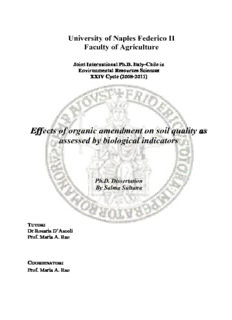
Effects of organic amendment on soil quality as assessed by biological indicators PDF
Preview Effects of organic amendment on soil quality as assessed by biological indicators
University of Naples Federico II Faculty of Agriculture Joint International Ph.D. Italy-Chile in Environmental Resources Sciences XXIV Cycle (2008-2011) Effects of organic amendment on soil quality as assessed by biological indicators Ph.D. Dissertation By Salma Sultana TUTOR: Dr Rosaria D‟Ascoli Prof. Maria A. Rao COORDINATOR: Prof. Maria A. Rao “Who hath created seven universes one above another: Thou seest not, in the creation of the All-merciful any incongruity, Return thy gaze, seest thou any rifts. Then Return thy gaze, again and again. Thy gaze, Comes back to thee dazzled, aweary” Al-Quran, (Chapter 67: Verse 3-4) This, in effect, is the faith of all scientists; the deeper we seek, the more is our wonder excited, the more is the dazzlement for our gaze INDEX Chapter 1 Introduction……………………………………………….... 1 1.1. Soil and its importance……………………………………………... 1 1.2 Agricultural use of soils ……………………………………………. 3 1.2.1 Intensive agricultural management and its impact …………………. 3 1.2.2 Sustainable agricultural management……………………………….. 7 1.3 Soil quality…………………………………………………………... 9 1.3.1 Qualitative approach in defining soil quality………………………... 12 1.3.2 Quantitative approaches in defining soil quality…………………….. 13 1.4 Soil quality indicators ……………………………………………… 14 1.4.1 Soil physical and chemical indicators……………………………….. 15 1.4.2 Soil biological indicators…………………………………………... 18 1.4.3 Soil microbial indices………………………………………………... 22 1.5. Soil organic matter ………………………………………………… 24 1.6. Importance of waste recycling to agricultural land………………. 31 1.6.1. Composted urban waste as an organic amendment…………………. 33 1.6.2. Pulp mill sludge as an organic amendment………………………….. 36 1.7 The role of biodiversity in soil …………………………………….. 39 1.7.1. Soil biodiversity and ecosystem functions ………………………….. 42 1.7.2. Soil biodiversity and agricultural sustainability…………………….. 46 1.7.3. Factors affecting soil biodiversity…………………………………… 48 1.8 Methods to asses microbial diversity in soil………………………. 50 1.8.1 Bacterial community structure by 16s rDNA-PCR-DGGE …………. 54 1.8.2 Soil functional diversity by substrate induced respiration (SIR)…….. 57 1.9. References…………………………………………………………… 61 Chapter 2 Aims……………………………………………………….. 95 Chapter 3 Use of slow-degradable organic amendments to improve quality of soils under intensive agricultural management............................................................................................ 97 3.1. Introduction…………………………………………………………. 97 3.2. Materials and methods…………………………………………....... 101 3.2.1 Study area…………………………………………………………...... 101 3.2.2 Physical and chemical properties of the tested 102 amendments…………..........................................................………. 3.2.3 Experimental Design…………………………………………............. 103 3.2.4 Soil amendment and samplings………………………………………. 105 3.2.5 Soil physical and chemical analyses……………............................... 106 3.2.6 Soil Biological analyses………………….…………………………... 107 3.2.7 Soil functional diversity………………………………………………. 108 3.2.8 Microbial indices……………………………………………………… 110 3.2.9 Statistical analyses……………………………………………………. 111 3.3 Result ………………………………………………………………… 112 3.3.1. Effect of organic amendment on soil physical and chemical properties 1 1 2 3.3.2. Effect of organic amendment on soil biological properties and microbial indices……………………………………………………... 129 3.3.3. Effect of organic amendment on functional diversity of the soil microbial community………………………………………………….. 143 3.4. Discussions…………………………………………………………… 154 3.5. Conclusions……………………………………………………........... 171 3.6. References……………………………………………………………. 174 Chapter 4 Bacterial community structure and enzymatic activities in a Chilean volcanic soil as affected by the addition of sludge from pulp and paper industry ....................................................................... 195 4.1. Introduction…………………………………………………………. 195 4.2. Materials and methodology………………………………………... 196 4.2.1 Study site and experimental design…………………………………... 196 4.2.2 Pulp sludge collection and preparation……………………………... 196 4.2.3 Soil sampling and storage…………………………………………… 197 4.2.4 Soil chemical analyses……………………………………………….. 198 4.2.5 Enzymatic analyses………………………………………………...… 199 4.2.6 Bacterial community structure analysis……………………………... 200 4.2.7 Cluster analysis …………………………………………………….. 202 4.2.8 Statistical analyses ………………………………………………….. 202 4.3. Results ………………………………………………………………. 203 4.4. Discussion…………………………………………………………. 209 4.5. Conclusion………………………………………………………… 214 4.6. References…………………………………………………………. 215 Chapter 5 General conclusion…………………………………………………... 227 Acknowledgment Chapter 1 Introduction 1.1 Soil and its importance Relevance of soils as a resource in terrestrial ecosystems has been pointed out on 30 May 1972 by the Committee of Ministers in the Council of Europe that has written the European Soil Charter, declaring: 1. Soil is one of humanity's most precious assets. It allows plants, animals and humans to live on the earth's surface 2. Soil is a limited resource which is easily destroyed 3. Industrial society uses land for agriculture as well as for industrial and other purposes. A regional planning system must be conceived in terms of the properties of the soil and the needs of today's and tomorrow's society 4. Farmers and foresters must implement methods that preserve the quality of the soil 5. Soil must be protected against erosion 6. Soil must be protected against contamination 7. Urban development must be planned so that it causes as little harm as possible to adjoining areas 8. In civil engineering projects, the effects on adjacent land must be assessed during planning, so that adequate protective measures can be reckoned in the cost 9. An inventory of land resources is indispensable 10. Further research and interdisciplinary collaboration are required to ensure wise use and conservation of the soil 11. Soil conservation must be taught at all levels and be kept to an ever-increasing extent in the public eye 1 Chapter 1 12. Governments and those in command must purposefully design and administer soil resources Soil is linked to everything around us and performs many vital roles in sustaining life on Earth. Moreover, the European Commission Communication on the Thematic Strategy have been identified and underlined the key role of soil in ecosystems as living and powerful element which supports plant and animal life, as a source of food and raw materials. It is a fundamental part of the biosphere that, together with vegetation and climate, helps to regulate the circulation and affects the quality of water (Blum, 2005; EC, 2006). Additionally, soil has filtering, buffering and transformation capabilities influencing the water cycle and the gas exchange between terrestrial and atmospheric systems and protecting the environment against the contamination of ground water and the food chain (Fig. 1.1). Fig. 1.1 Filtering, buffering and transformation activities of soil (Blum, 2005). 2
Description: